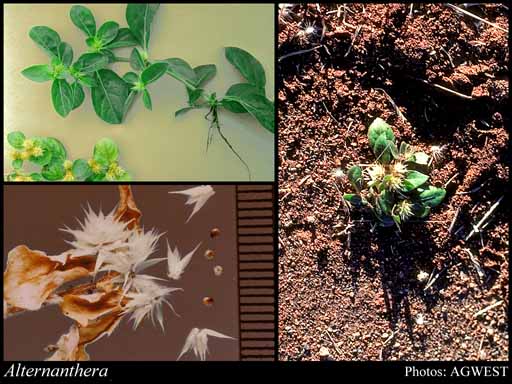- Reference
- Fl.Aegypt.-Arab. 28 (1775)
- Name Status
- Current

Scientific Description
Family Amaranthaceae.
Habit and leaf form. Sub- shrubs, or herbs (erect to scrambling). Herbs annual, or perennial; plants with neither basal nor terminal concentrations of leaves. Leaves opposite; petiolate, or subsessile, or sessile; simple. Leaf blades entire; elliptic, or oblong, or ovate, or obovate, or linear; pinnately veined; attenuate at the base. Leaves without stipules. Leaf blade margins entire, or dentate. Leaf anatomy. Hairs present, or absent.
Reproductive type, pollination. Fertile flowers hermaphrodite. Unisexual flowers absent. Plants hermaphrodite.
Inflorescence and flower features. Flowers aggregated in ‘inflorescences’; in spikes. The terminal inflorescence unit cymose. Inflorescences axillary; short, dense usually sessile. Flowers sessile; bracteate; bracteolate. Bracteoles scarious or membranous. Flowers regular, or somewhat irregular; cyclic. Free hypanthium absent. Hypogynous disk absent. Perianth sepaline; 5. Calyx present; 5; polysepalous; hairy, or glabrous; regular, or unequal but not bilabiate; white, or yellow; scarious with a prominent midrib; persistent; with the median member posterior. Sepals oblong, or ovate. Corolla absent. Androecium 2–5. Androecial members all equal, or markedly unequal; coherent; 1 - adelphous (the filaments basally connate forming a short staminal cup); 1 -whorled. Androecium exclusively of fertile stamens, or including staminodes (with some members occasionally lacking anthers, and usually with pseudo-staminodes alternating with the true androecium; the pseudo-staminodes varying from very small and tooth-like to large and dentate or laciniate). Staminodes when present, 2–3. Stamens 2–5; oppositisepalous. Anthers dehiscing via longitudinal slits; introrse; unilocular. Pollen shed as single grains. Gynoecium 2–3 carpelled. The pistil 1 celled. Gynoecium syncarpous; eu-syncarpous; superior. Ovary unilocular; 1 locular. Gynoecium stylate. Styles 1 (very short). Stigmas 1; 1 - lobed; capitate. Placentation basal. Ovules in the single cavity 1; pendulous; non-arillate; campylotropous.
Fruit and seed features. Fruit indehiscent; capsular-indehiscent (a utricle, thin-walled or sometimes corky, dispersed with perianth, and sometimes bracteoles, attached); 1 seeded. Seeds lenticular; non-endospermic (strictly speaking). Perisperm present (abundant, mealy). Embryo well differentiated. Cotyledons 2. Embryo curved. Testa smooth (usually shiny).
Special features. Perianth (calyx) woolly outside, or glabrous outside.